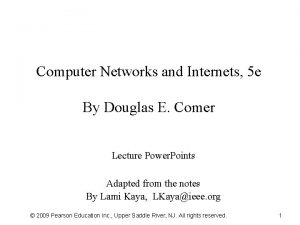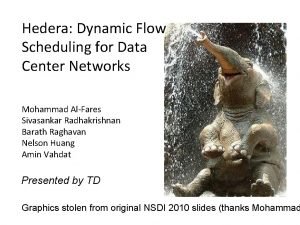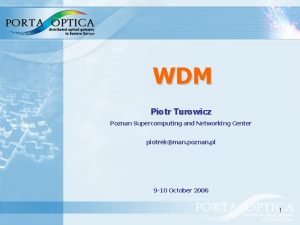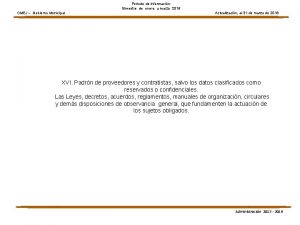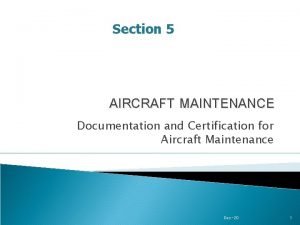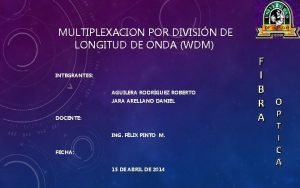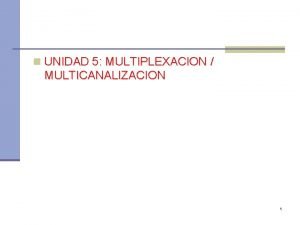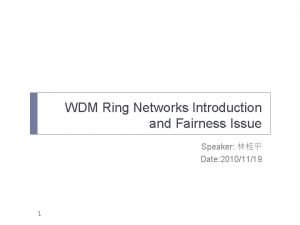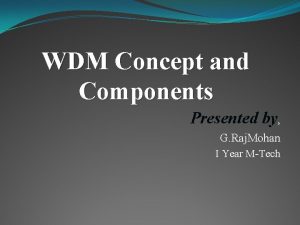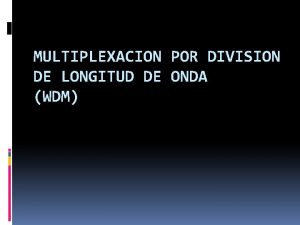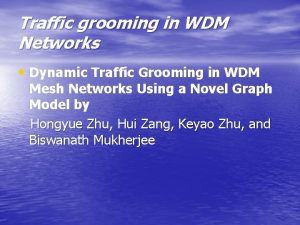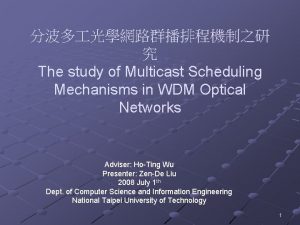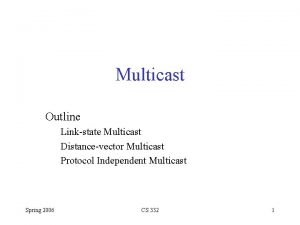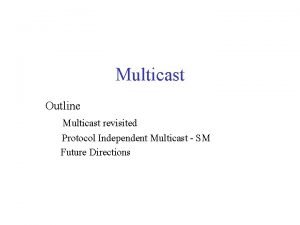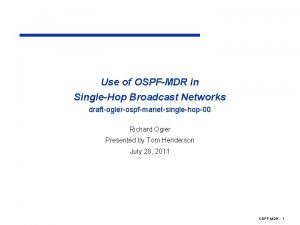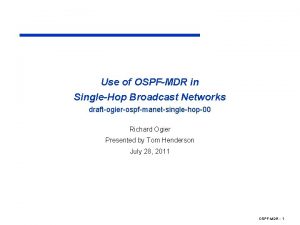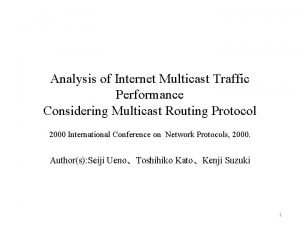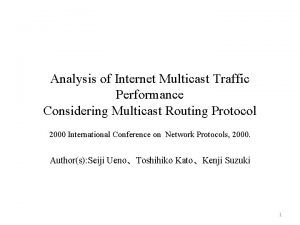Multicast Traffic Scheduling in SingleHop WDM Networks with





















- Slides: 21

Multicast Traffic Scheduling in Single-Hop WDM Networks with Tuning Latencies Ching-Fang Hsu Department of Computer Science and Information Engineering National Cheng Kung University June 2004

Outline Network Model v Qo. S Parameters v Multicast Qo. S Traffic Scheduling Algorithm v The Maximum Assignable Slots (MAS) Problem v The Optimal MAS Solution v Near-optimal Solutions to The MAS Problem v Performance Evaluation v Conclusions v

Network Model v A broadcast-and-select star-coupler topology is considered.

Network Model (contd. ) Transmission in the network operates in a time-slotted fashion. v The normalized tuning delay , is expressed in units of cell duration. v All transceivers are tunable over all wavelengths with the same delay. v u Each station is equipped with a pair of fixed transceivers (control channel) and a pair of tunable transceivers (data channel).

Qo. S Parameters CBR and ABR traffic types are considered. v Multicast virtual circuits (MVC’s) v A 2 -tuple notation <c, d> to describe cell rate v is the maximum number of slots that can arrive in any d slots. u For CBR transmission, d is also the relative deadline, i. e. , a cell of a CBR MVC must be sent before slot t+d if it arrives in slot t uc u For an ABR VC, <c, d> just means that slots within a L-slot period should be assigned to it.

Qo. S Parameters (contd. ) v Minimum cell rate (MCR) and peak cell rate (PCR) u For a CBR MVC, MCR=PCR v 6 -tuple u <cm, notation to identify a MVC dm, cp, dp, s, M> o MCR, PCR, the source ID, and the set of destination Ids o For a CBR MVC, < cp, dp > = <-1, -1>

Qo. S Parameters (contd. ) v Each CBR MVC has its own deadline (dm), or local cycle length. v Global cycle length -- the period of a traffic scheduling containing CBR traffic where { | cycle length of MVCi's MCR} u L=lcm( ), is the local

: MVC 1, <3, 8, -1, s 1, {m 1, m 2}> : MVC 2, <3, 4, -1, s 2, {m 3, m 4}> W = 3, = 1 : MVC 3, <1, 4, s 3, {m 5, m 6}>

The Multicast Qo. S Traffic Scheduling Problem v Given N stations, W available wavelengths for data transmission, L-slot global cycle and a W L slotallocation matrix D; each station is equipped with a pair of tunable transceiver and each needs time slots for tuning from i to j, i j. For a setup request rs = < cm, dm, cp, dp, s, M >, find a new feasible slotallocation matrix Dnew with a new global cycle length Lnew such that rs is arranged into Dnew and all the Qo. S requirements of accepted MVC's in D are not affected.

The Multicast Qo. S Traffic Scheduling Algorithm

The Multicast Qo. S Traffic Scheduling Algorithm -Available Slot Scan v Available slot matrix A u. A v = [aij]W L , aij {0, 1} Some nonzero entries may not be allocated simultaneously due to the tuning latency constraint.

(b) D and A for a request MVC 3 = <1, 16, -1, s 1, {m 3, m 4}> B: 1 1 0 0 0 0 0 0 0 (c) Assignable matrix B for A in (b)

The Multicast Qo. S Traffic Scheduling Algorithm -- The Maximum Assignable Slots (MAS) Problem v How to retrieve the maximum available slots concurrently for assignment from available matrix A? u Derive an auxiliary graph with each entry in A with value 1 as a node and a link is created between two nodes whose representative entries can be assigned concurrently. u Find the maximum clique in the graph


The Optimal MAS (OMAS) Solution v The Optimal MAS (OMAS) Strategy u Comparability graphs o An undirected graph G = (V, E) is a comparability graph if there exists an orientation (V, F) of G satisfying F F-1 = , F + F-1 = E, F 2 F, where F 2 = {ac | ab, bc F} o The maximum clique problem is polynomialtime solvable in comparability graphs.

Optimal MAS (OMAS) Solution (contd. ) v Auxiliary Graph Transformation each nonzero entry aij in the first columns, move the column contains aij to the leftmost and then set all entries that cannot be assigned concurrently with aij to zero. The auxiliary graph of the new matrix Pij is a comparability graph. u Set the entries of the first columns to zero, the auxiliary graph of the new matrix Q is a comparability graph. u For v The OMAS solution is the maximum of the solutions among Pij and Q


Near- Optimal Solutions to The MAS Problem v v The time complexity of OMAS strategy is O( W|A|2) in the worst case. Longest Segment First (LSF) u u u v A segment : a set of continuous available time slots on the same wavelength Assign the slots on the segment basis O(|A|2 log|A|) Freest Wavelength First (FWF) u u u Freest wavelength : the wavelength that contains the most available time slots Assign the slots on the wavelength basis O(W|A|log|A|)

Longest Segment First (LSF) Freest Wavelength First (FWF)

Performance Evaluation 0. 0386 LSF FWF Blocking Probability 0. 0376 OMAS 0. 0366 0. 0356 0. 0346 0. 0336 0. 0326 1 2 3 4 5 6 Tuning Latency 7 d 8 9 10

Conclusions v Qo. S multicast services in WDM starcoupled networks is investigated. v The slot scanning problem is defined as the MAS problem and its optimal solution is derived. v FWF is a considerable replacement of OMAS for its lower complexity and nearoptimal blocking performance.
 Fdm tdm wdm in computer networks
Fdm tdm wdm in computer networks Job scheduling vs process scheduling
Job scheduling vs process scheduling Inbound traffic vs outbound traffic
Inbound traffic vs outbound traffic All traffic solutions traffic cloud
All traffic solutions traffic cloud Hedera: dynamic flow scheduling for data center networks
Hedera: dynamic flow scheduling for data center networks Traffic management in computer networks
Traffic management in computer networks Ftコミュニケーションズ 交換機
Ftコミュニケーションズ 交換機 Wdm
Wdm Wdm concept
Wdm concept Fiber optic wdm
Fiber optic wdm Wdm 990126350
Wdm 990126350 Dwdm lambda
Dwdm lambda Aircraft maintenance documentation
Aircraft maintenance documentation Wdm ring
Wdm ring Wdm
Wdm Tdm wdm fdm
Tdm wdm fdm Wdm network
Wdm network Wdm concept
Wdm concept Wdf_interrupt_config_init
Wdf_interrupt_config_init Multiplexación por división de longitud de onda (wdm)
Multiplexación por división de longitud de onda (wdm) Difference between virtual circuit and datagram subnet
Difference between virtual circuit and datagram subnet Backbone networks in computer networks
Backbone networks in computer networks
